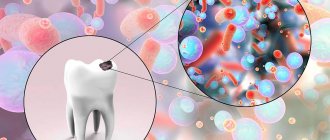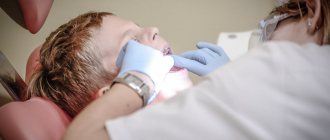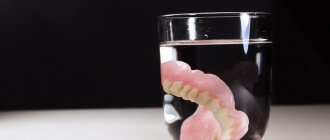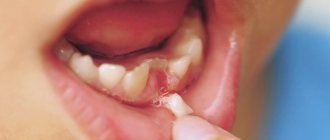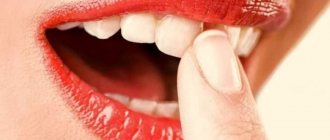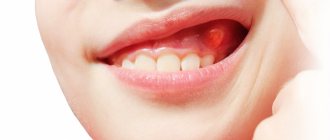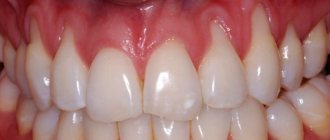According to statistics, 98% of people are afraid of visits to the dentist. As a result, solutions to dental problems are postponed until the last minute, until one day we discover that the tooth has rotted. Then a visit to the doctor is inevitable, but a lot of work remains.
Contrary to popular belief, rotten teeth are not only a result of poor hygiene.
Causes of tooth decay
Yes, we all know that you need to brush your teeth 2 times a day, be sure to use dental floss and visit the dentist 2 times a year. Many patients follow these recommendations, but their teeth still deteriorate and rot. Poor hygiene is not the only reason why teeth deteriorate. There are other factors:
- Gum diseases
provoke the proliferation of bacteria, which literally gnaw through the enamel and destroy tooth tissue; - genetics
plays a role in the ability of teeth to resist pathogenic factors; - an unfavorable ecological environment
leads to the fact that in industrial areas there are more dental problems than in places where there are no factories; - Water quality
directly affects teeth. Low content of useful minerals (fluorine, calcium), high content of heavy metal salts can destroy teeth, despite hygiene; - bad habits
. Smokers have worse teeth than non-smokers and treatment is more difficult; - general diseases
, for example, problems with the gastrointestinal tract, negatively affect the condition of the teeth; - carbohydrates
in the diet , as well as hard food products that injure the gums and enamel lead to tooth decay.
To understand why teeth rot, you need to undergo an examination. Don’t be surprised if the doctor asks you to take tests or do an ultrasound. Dental treatment requires a comprehensive approach and diagnosis is more important than ever. Having found out why teeth are rotting, the doctor will prescribe adequate treatment.
Treatment in dentistry
Whether a tooth can be treated depends on the severity of the carious process, so doctors first prescribe x-rays to patients. If the situation is not critical and the dentist can save the tooth from rotting, he carefully cleans it of accumulated deposits (plaque and stone) and begins treatment:
- Anesthesia is performed.
- All areas of enamel affected by the carious process are removed, and the rotting pulp must also be removed.
- The dental cavity is washed with an antiseptic.
- The integrity of the surface is restored with filling material. After the filling is installed and hardened, the patient must check the bite: if discomfort is felt, the excess layer of filling material must be removed.
Teeth that are rotting from the gums are treated in the same way, but photopolymer materials are usually used to fill them. They harden quickly, are characterized by increased strength and high aesthetics.
The dentist may prescribe an antibiotic to prevent the infection from spreading throughout the body. For severe pain, an analgesic is prescribed.
There are methods that can be used to prevent damage to dental tissues by cariogenic bacteria. Almost all dental clinics carry out remineralization - strengthening the enamel structure with special preparations. In a hospital or at home, you can perform fluoridation - saturating the enamel with fluoride.
Stages
Caries, like a secret agent, begins to act on the sly and may not make itself felt for years. Its initial stage is called the “white spot stage.” Well, how can you see white on white? That is why it is important to visit the dentist regularly - the specialist will highlight the white spot against the background of the enamel and cure caries in time. And if you start it, the disease goes to the next level:
- Surface.
The enamel is still intact, but in the area of the stain it becomes rough. The stain deepens. The tooth begins to react to cold and hot. - Average.
Caries penetrates to the dentin, but it does not provide access to the pulp. A damaged tooth reacts to temperature, mechanical, and chemical stimuli. But the pain is not constant, it goes away quickly. - Deep.
The pain is sharp when touched, but gradually subsides. A carious cavity is visible to the naked eye.
CONCLUSIONS:
As you can see from the examples provided, I, orthopedic dentist Sergei Samsakov, an expert in the field of digital modeling and restoration of teeth using Cerec, manage to restore a beautiful smile even in almost the most hopeless cases. If you have similar problems, do not hesitate, contact us, and we will always find the optimal and, most importantly, beautiful solution to your situation.
And remember the simple truth: there are no hopeless situations!
Why do children's teeth rot?
In children, the composition of saliva is not the same as in adults. Its antibacterial properties are low; in a warm, humid environment, microbes multiply quickly. The disease is not only common, it progresses rapidly. Caries spreads in width and depth. Single events are rare; usually several teeth are affected at once. For children, timely identification and treatment of problem teeth is of particular importance. Rotten teeth can cause:
- pulpitis and periodontitis;
- malocclusion;
- loss of milk and permanent teeth;
- inflammation of the maxillofacial apparatus.
Bad teeth affect the social adaptation of children and lead to psychological problems.
Prevention includes hygiene procedures, limiting sweets, a balanced diet and regular dental examinations.
Prevention
To prevent pathologies, you should regularly perform professional oral hygiene. This is a whole range of procedures performed by a hygienist in an office setting. They are aimed at removing contamination from the surface of the crowns and removing plaque from under the gum tissue. Such an event is in demand today as a prevention of caries and gum disease. It provides fresh breath, brightens the enamel, and makes your smile beautiful. Hygienists carefully treat the spaces between units, which reduces the risk of gingivitis and periodontitis. Cleaning in the dentist's office is performed using ultrasound, air abrasive methods and other modern methods.
Of course, it is better not to allow putrefactive appearances on the incisors, fangs, and molars at all. To do this, you should carefully monitor your oral cavity. It is important to carry out hygiene procedures twice a day. You should not overuse baked goods and sweets. These products damage enamel in the same way as sweet soda with a high level of harmful components. It is necessary to include natural products in the diet. You need to visit the dentist every 6 months. The doctor will conduct the necessary examinations in a timely manner, identify the pathology, and select a therapeutic program.
Teeth and pregnancy
We found out why children's teeth rot. There is another group of people particularly at risk of tooth decay. These are pregnant women. Some scientists classify pregnancy as an immunodeficiency state - the body's resistance to pathogens decreases to such an extent. It’s no wonder that during pregnancy, general diseases worsen and dental problems begin. The increased content of hormones in the body reduces the barrier ability of the epithelium, microorganisms more easily penetrate the gums and begin to multiply.
Help protect your teeth:
- rational and balanced diet;
- multivitamin complexes;
- professional oral hygiene;
- herbal baths;
- applications with calcium and phosphates.
Symptoms of the disease
The process usually occurs without symptoms, but pain may occur when brushing a toothbrush, eating sour, salty, sweet, cold or hot foods.
After eliminating the irritant, everything goes away. The patient can see a doctor if a stain is found on the front surface of the incisors, but often it is hidden under plaque or tartar.
The ongoing carious process gradually reaches the dentin junction, penetrating first into its surface layers and then further. The cavity deepens with bacteria and food debris. There is a smell from the mouth. Irritants cause pain more and more frequently.
With cement caries, teeth become mobile and lose their support, and bleeding gums occur. These are already symptoms of periodontitis. Now, even when chewing food or brushing teeth, severe discomfort occurs.
Digestion begins to suffer. Teeth become hypersensitive to hot or cold.
Next, the process follows the Leus classification:
- Active lesion - the edges of the cavity are undermined. The cavity is filled with softened tissues and tends to grow.
- Suspended caries - no increase in the affected area is observed. The cavity is clean, the bottom is shiny and smooth, the edges are even and dense.
- Secondary caries - occurs under a filling.
What to do if a tooth is rotten
Until recently, the only solution to the problem was deletion. Today, dental science offers various methods and techniques for restoring teeth.
The method of influence depends on the specific case. What matters is the depth of the lesion, its area, the stage of the disease and the degree of destruction.
Treatment at the initial stage
At the stain stage, you can do without a drill, because it is this that frightens you the most and makes you put off visiting a doctor.
Apply:
- Ozone therapy
. Ozone treatment destroys bacteria, and special preparations restore enamel. - The laser
also destroys bacteria, without heating the tissue and serves as a good preventive measure for gum disease. - Infiltration treatment
.
The chemical composition destroys bacteria, and the infiltration material “seals” the enamel pores and prevents pathogens from penetrating inside.
Treatment for moderate and severe stages
If the disease is advanced, the dentist will still try to save the tooth. At the same time, you can no longer do without a drill. After the examination, the doctor decides how to treat the decayed tooth. But the general principles are the same: after the administration of anesthesia, all dead tissue is removed, the cavity is disinfected and a filling is placed.
If the crown of a tooth has rotted, but the root has been preserved, after treatment the tooth is prepared for prosthetics using:
- Inlays under the stump.
They replace damaged tooth tissue. Inlays are made from zirconium, ceramics, and precious metals. One part of the tab is inserted into the dental canal, and a crown is put on the other. - Pins.
A pin is a rod that is inserted into the dental canal, and a crown is installed on top. They are made of metal or fiberglass.
Modern prosthetics offer a huge variety of materials. Crowns are made from traditional materials: metals and metal-ceramics, composites, zirconium alloys, and modern metal-free compounds.
Features of Cerec technology
Cerec root inserts and crowns are made from metal-free materials - it can be ceramic or zirconium dioxide. They can be installed even for allergy sufferers without fear. This technology has completely changed traditional approaches to dentistry.
Now the restoration process is comfortable and takes a minimum of time. In my clinic, the procedure is carried out in several stages.
I would also like to note that only one anesthesia is required and there are practically no errors when creating new teeth. Stages:
- An intraoral scanner determines the boundaries of the damage. This is especially important when only the roots of the front teeth or molars remain. The remaining tissues, antagonist teeth, and closed rows are scanned.
- The information is transferred to a computer, where all the images are combined into an image.
- The program creates a three-dimensional model of the remaining tooth, all defects are clearly visible. Then models of the inlay and crown are created that perfectly replicate the anatomical features of the tooth. Dimensions and shape are calculated accurately. It is determined what kind of restoration is needed.
- The design is made from blanks on a milling module. The elements are being tried on. In rare cases, correction is required. Shade discrepancies or other issues that displease the patient can be easily corrected within a few minutes.
- The completed root inlay fits hermetically to the remaining parts of the tooth, is securely fixed and exactly matches the shape.
Thus, it is possible to quickly restore units if only the roots of the teeth of the lower or upper jaw remain.
Implantation is a solution for advanced cases
Alas, if the root of a tooth has rotted, then the only solution is removal. But even here, dentists offer a method that will help restore a rotten tooth - implantation. The implant will stop bone loss, prevent loosening and tilting of neighboring teeth, and restore your smile. The immediate loading method involves placing an implant immediately after tooth extraction. There is no need to wait for the hole to heal and you can chew almost immediately.
How to determine if a root is healthy
How to understand whether caries has affected the root of the tooth, whether the dentin of the tooth root is intact or whether there are defects? In order to have an objective picture of the process, it is necessary to perform an x-ray of the tooth root and a computed tomogram. A CT scan will determine the true condition of the root and show:
- The presence of inflammatory processes.
- It will determine whether there are neoplasms and what size they are (cyst or granuloma).
- The location of the roots in relation to the neighboring ones, the maxillary sinus.
This is the only way to see whether it will be possible to cure the tooth root using a tab.

